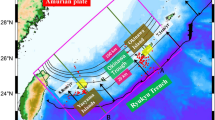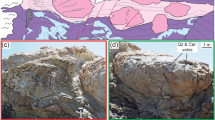Abstract
The cause of intermediate-depth (50–300 km) seismicity in subduction zones is uncertain. It is typically attributed either to rock embrittlement associated with fluid pressurization, or to thermal runaway instabilities. Here we document glassy pseudotachylyte fault rocks—the products of frictional melting during coseismic faulting—in the Lanzo Massif ophiolite in the Italian Western Alps. These pseudotachylytes formed at subduction-zone depths of 60–70 km in poorly hydrated to dry oceanic gabbro and mantle peridotite. This rock suite is a fossil analogue to an oceanic lithospheric mantle that undergoes present-day subduction. The pseudotachylytes locally preserve high-pressure minerals that indicate an intermediate-depth seismic environment. These pseudotachylytes are important because they are hosted in a near-anhydrous lithosphere free of coeval ductile deformation, which excludes an origin by dehydration embrittlement or thermal runaway processes. Instead, our observations indicate that seismicity in cold subducting slabs can be explained by the release of differential stresses accumulated in strong dry metastable rocks.
This is a preview of subscription content, access via your institution
Access options
Access Nature and 54 other Nature Portfolio journals
Get Nature+, our best-value online-access subscription
$29.99 / 30 days
cancel any time
Subscribe to this journal
Receive 12 print issues and online access
$259.00 per year
only $21.58 per issue
Buy this article
- Purchase on Springer Link
- Instant access to full article PDF
Prices may be subject to local taxes which are calculated during checkout





Similar content being viewed by others
References
Kirby, S. H., Engdahl, E. R. & Denlinger R. in Subduction: Top to Bottom (eds G. E. Bebout et al.) 195–214 (Geophysics Monograph Series 96, AGU, Washington DC, 1996).
Hacker, B. R., Peacock, S. M., Abers, G. A. & Holloway, S. D. Subduction factory 2. Are intermediate-depth earthquakes in subducting slabs linked to metamorphic dehydration reactions? J. Geophys. Res. 108, 2030 (2003).
Frohlich, C. The nature of deep-focus earthquakes. Ann. Rev. Earth Planet. Sci. 17, 227–254 (1989).
Abers, G. A. Seismic low-velocity layer at the top of subducting slabs: observations, predictions, and systematics. Phys. Earth Planet. Int. 149, 7–29 (2005).
Bostock, M. G. The Moho in subduction zones. Tectonophysics 609, 547–557 (2013).
Audet, P., Bostock, M. G., Christensen, N. I. & Peacock, S. M. Seismic evidence for overpressured subducted oceanic crust and megathrust fault sealing. Nature 457, 76–78 (2009).
Kodaira, S. et al. High pore fluid pressure may cause silent slip in the Nankai Trough. Science 304, 1295–1298 (2004).
Ogawa, M. Shear instability in a viscoelastic material as the cause of deep focus earthquakes. J. Geophys. Res. 92, 13801–13810 (1987).
Braeck, S. & Podladchikov, Y. Y. Spontaneous thermal runaway as an ultimate failure mechanism of materials. Phys. Rev. Lett. 98, 095504 (2007).
Kelemen, P. B. & Hirth, G. A. Periodic shear-heating mechanism for intermediate-depth earthquakes in the mantle. Nature 446, 787–790 (2007).
John, T. et al. Generation of intermediate-depth earthquakes by self-localizing thermal runaway. Nat. Geosci. 2, 137–140 (2009).
Thielmann, M., Rozel, A., Kaus, B. J. P. & Ricard, Y. Intermediate-depth earthquake generation and shear zone formation caused by grain size reduction and shear heating. Geology 43, 791–794 (2015).
Jung, H., Green, H. W. II & Dobrzhinetskaya, L. F. Intermediate-depth earthquake faulting by dehydration embrittlement with negative volume change. Nature 428, 545–549 (2004).
Okazaki, K. & Hirth, G. Dehydration of lawsonite could directly trigger earthquakes in subducting oceanic crust. Nature 530, 81–85 (2016).
Green, H. W. II, Shi, F., Bozhilov, K., Xia, G. & Reches, Z. Phase transformation and nanometric flow cause extreme weakening during fault slip. Nat. Geosci. 8, 484–490 (2015).
Austrheim, H. & Boundy, T. M. Pseudotachylytes generated during seismic faulting and eclogitization of the deep crust. Science 265, 82–83 (1994).
Austrheim, H. et al. Fragmentation of wall rock garnets during deep crustal earthquakes. Sci. Adv. 3, e1602067 (2017).
John, T. & Schenk, V. Interrelations between intermediate-depth earthquakes and fluid flow within subducting oceanic plates: constraints from eclogite facies pseudotachylytes. Geology 34, 557–560 (2006).
Austrheim, H. & Andersen, T. B. Pseudotachylytes from Corsica: fossil earthquakes from a subduction complex. Terra Nova 16, 193–197 (2004).
Andersen, T. B. & Austrheim, H. Fossil earthquakes recorded by pseudotachylytes in mantle peridotite from the Alpine subduction complex of Corsica. Earth Planet. Sci. Lett. 242, 58–72 (2006).
Deseta, N., Andersen, T. B. & Ashwal, L. D. A weakening mechanism for intermediate-depth seismicity? Detailed petrographic and microtextural observations from blueschist facies pseudotachylytes, Cape Corse, Corsica. Tectonophysics 610, 138–149 (2014).
Deseta, N., Ashwal, L. D. & Andersen, T. B. Initiating intermediate-depth earthquakes: insights from a HP–LT ophiolite from Corsica. Lithos 206–207, 127–146 (2014).
Piccardo, G. B., Ranalli, G. & Guarnieri, L. Seismogenic shear zones in the lithospheric mantle: ultramafic pseudotachylytes in the Lanzo peridotite (Western Alps, NW Italy). J. Petrol. 51, 81–100 (2010).
Piccardo, G. B., Ranalli, G., Marasco, M. & Padovano, M. Ultramafic pseudotachylytes in the Mt. Moncuni peridotite (Lanzo Massif, Western Alps): tectonic evolution and upper mantle seismicity. Period. Mineral. 76, 181–197 (2007).
Vitale Brovarone, A. et al. Stacking and metamorphism of continuous segments of subducted lithosphere in a high-pressure wedge: the example of Alpine Corsica (France). Earth Sci. Rev. 116, 35–56 (2013).
Debret, B., Nicollet, C., Andreani, M., Schwartz, S. & Godard, M. Three steps of serpentinization in an eclogitized oceanic serpentinization front (Lanzo Massif – Western Alps). J. Metam. Geol. 31, 165–186 (2013).
Kienast, J. R. & Pognante, U. Chloritoid-bearing assemblages in eclogitised metagabbros of the Lanzo peridotite body (Western Italian Alps). Lithos 21, 1–11 (1988).
Pelletier, L. & Müntener, O. High pressure metamorphism of the Lanzo peridotite and its oceanic cover, and some consequences for the Sesia–Lanzo zone (northwestern Italian Alps). Lithos 90, 111–130 (2006).
Rubatto, D., Müntener, O., Barnhoorn, A. & Gregory, C. Dissolution–reprecipitation of zircon at low-temperature, high-pressure conditions (Lanzo Massif, Italy). Am. Mineral. 93, 1519–1529 (2008).
Scambelluri, M., Muentener, O., Ottolini, L., Pettke, T. & Vannucci, R. The fate of B, Cl and Li in the subducted oceanic mantle and in the antigorite-breakdown fluids. Earth Planet. Sci. Lett. 222, 217–234 (2004).
Lund, M. G. & Austrheim, H. High-pressure metamorphism and deep-crustal seismicity: evidence from contemporaneous formation of pseudotachylytes and eclogite facies coronas. Tectonophysics 372, 59–83 (2003).
Lund, M. G., Austrheim, H. & Herambert, M. Earthquakes in the deep continental crust — insights from studies on exhumed high-pressure rocks. Geophys. J. Int. 158, 569–576 (2004).
Abers, G. A., Nakajima, J., van Keken, P. E., Kita, S. & Hacker, B. R. Thermal–petrological controls on the location of earthquakes within subducting plates. Earth Planet. Sci. Lett. 369–370, 178–187 (2013).
Prieto, G. A., Florez, M. & Barrett, S. A. Seismic evidence for thermal runaway during intermediate-depth earthquake rupture. Geophys. Res. Lett. 40, 6064–6068 (2013).
Prieto, G. A., Froment, B., Yu, C., Poli, P. & Abercrombie, R. Earthquake rupture below the brittle–ductile transition in continental lithospheric mantle. Sci. Adv. 3, e1602042 (2017).
Andersen, T. B., Mair, K., Austrheim, H., Podladchikov, Y. Y. & Vrijmoed, J. C. Stress release in exhumed intermediate and deep earthquakes determined from ultramafic pseudotachylyte. Geology 36, 995–998 (2008).
Dobson, D., Meredith, P. & Boon, S. Simulation of subduction zone seismicity by dehydration of serpentine. Science 298, 1407–1410 (2002).
Gasc, J. et al. Simultaneous acoustic emissions monitoring and synchrotron X-ray diffraction at high pressure and temperature: calibration and application to serpentinite dehydration. Phys. Earth Planet. Int. 189, 121–133 (2011).
Proctor, B. & Hirth, G. Role of pore fluid pressure on transient strength changes and fabric development during serpentine dehydration at mantle conditions: Implications for subduction-zone seismicity. Earth Planet. Sci. Lett. 421, 1–12 (2015).
Ferrand, T. et al. Dehydration-driven stress transfer triggers intermediate-depth earthquakes. Nat. Commun. 8, 15247 (2017).
Faccenda, M. & Mancktelow, N. S. Fluid flow during unbending: implications for slab hydration, intermediate-depth earthquakes and deep fluid subduction. Tectonophysics 494, 149–154 (2010).
Kita, S., Okada, T., Nakajima, J., Matsuzawa, T. & Hasegawa, A. Existence of a seismic belt in the upper plane of the double seismic zone extending in the along-arc direction at depths of 70–100 km beneath NE Japan. Geophys. Res. Lett. 33, L24310 (2006).
Rondenay, S., Abers, G. A. & van Keken, P. E. Seismic imaging of subduction zone metamorphism. Geology 36, 275–278 (2008).
Kawakatsu, H. & Watada, S. Seismic evidence for deep-water transportation in the mantle. Science 316, 1468–1471 (2007).
Kato, A. et al. Variations of fluid pressure within the subducting oceanic crust and slow earthquakes. Geophys. Res. Lett. 37, L14310 (2010).
Angiboust, S., Wolf, S., Burov, E., Agard, P. & Yamato, P. Effect of fluid circulation on subduction interface tectonic processes: insights from thermo-mechanical numerical modelling. Earth Planet. Sci. Lett. 357–358, 238–248 (2012).
Ide, S., Shelly, D. R. & Beroza, G. C. The mechanism of deep low frequency earthquakes: further evidence that deep non-volcanic tremor is generated by shear slip on the plate interface. Geophys. Res. Lett. 34, L03308 (2007).
Faccenda, M., Burlini, L., Gerya, T. & Mainprice, D. Fault-induced seismic anisotropy by hydration in subducting oceanic plates. Nature 455, 1097–1101 (2008).
Angiboust, S. & Agard, P. Initial water budget: the key to detaching large volumes of eclogitized oceanic crust along the subduction channel? Lithos 120, 453–474 (2010).
Angiboust, S., Agard, P., Yamato, P. & Raimbourg, H. Eclogite breccias in a subducted ophiolite. A record of intermediate-depth earthquakes? Geology 40, 707–710 (2012).
Acknowledgements
We greatly benefitted from discussions with P. Agard, T. Ferrand, A. Schubnel, O. Onken, E. Cannaò and S. Poli and from constructive comments by T. B. Andersen. We thank M. Kendrick for revising the pre-submission manuscript, and A. Risplendente and L. Negretti for technical assistance during the SEM and wavelength-dispersive spectrometry microprobe work. M.S. and M.G. acknowledge funding by the People Programme (Marie Curie Actions, European Union’s Seventh Framework Programme FP7/2007—2013) to the Initial Training Network ZIP (Zooming In-between Plates, REA grant agreement no. 604713). Discussions within ZIP stimulated this work. M.S. also acknowledges support from the Italian MIUR and the University of Genova. G.P. acknowledges funding of the University of Padova.
Author information
Authors and Affiliations
Contributions
M.S., G.P. and O.P. wrote the paper. M.S., G.P. and M.G. carried out the fieldwork, and the petrographic and microstructural study. M.B. did the field-emission SEM and EBSD work. O.P. did the TEM work. F.N. did the XRD and Raman analysis. M.S. and G.P. developed the concept.
Corresponding author
Ethics declarations
Competing interests
The authors declare no competing financial interests.
Additional information
Publisher’s note: Springer Nature remains neutral with regard to jurisdictional claims in published maps and institutional affiliations.
Supplementary Information
Supplementary Information
This file provides extended discussion and figures of: (1) the regional geological setting of the rocks studied (Supplementary Figure 1); (2) the microstructures of pseudotachylyte and cataclasite in gabbro (Supplementary Section 1); and (3) the microstructures of pseudotachylyte in eclogitic metagabbro and meta-peridotite (Supplementary Section 2)
Supplementary dataset
Experimental data
Rights and permissions
About this article
Cite this article
Scambelluri, M., Pennacchioni, G., Gilio, M. et al. Fossil intermediate-depth earthquakes in subducting slabs linked to differential stress release. Nature Geosci 10, 960–966 (2017). https://doi.org/10.1038/s41561-017-0010-7
Received:
Accepted:
Published:
Issue Date:
DOI: https://doi.org/10.1038/s41561-017-0010-7



